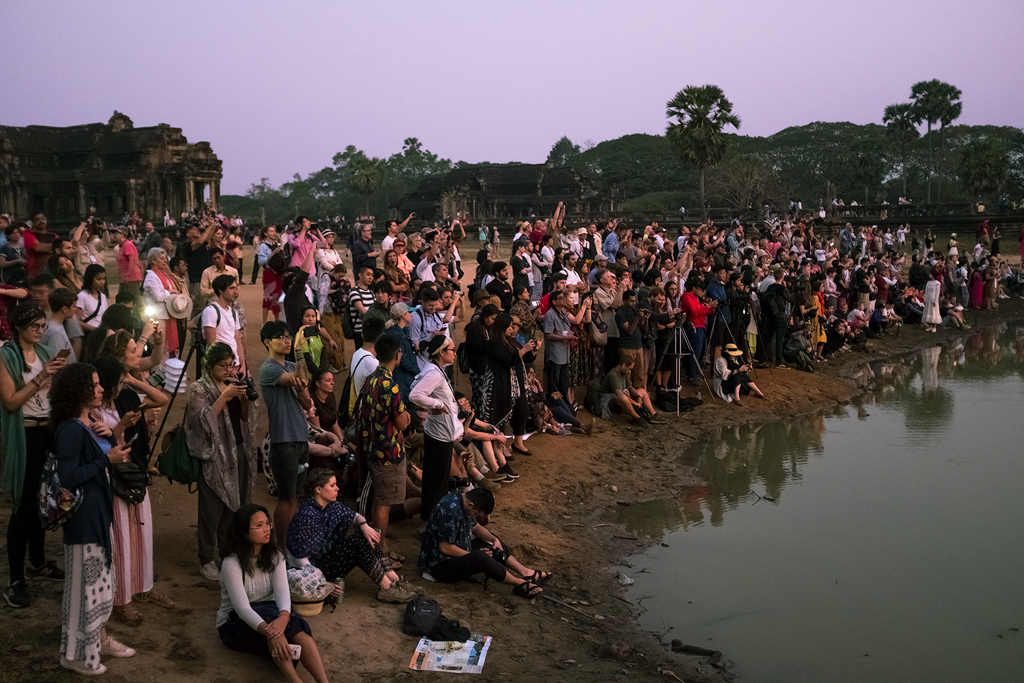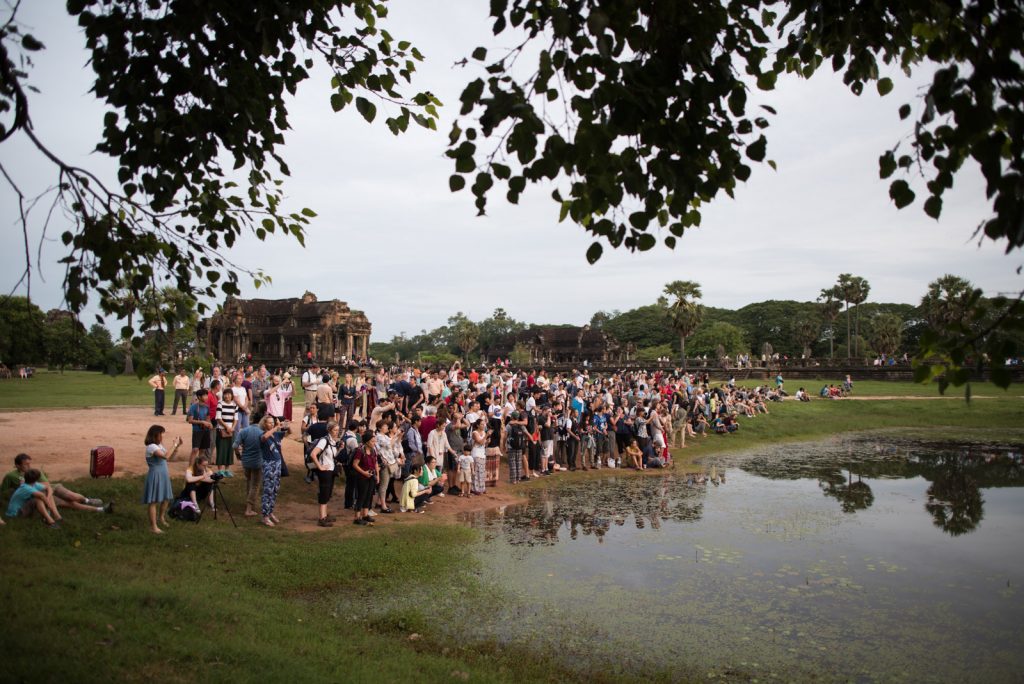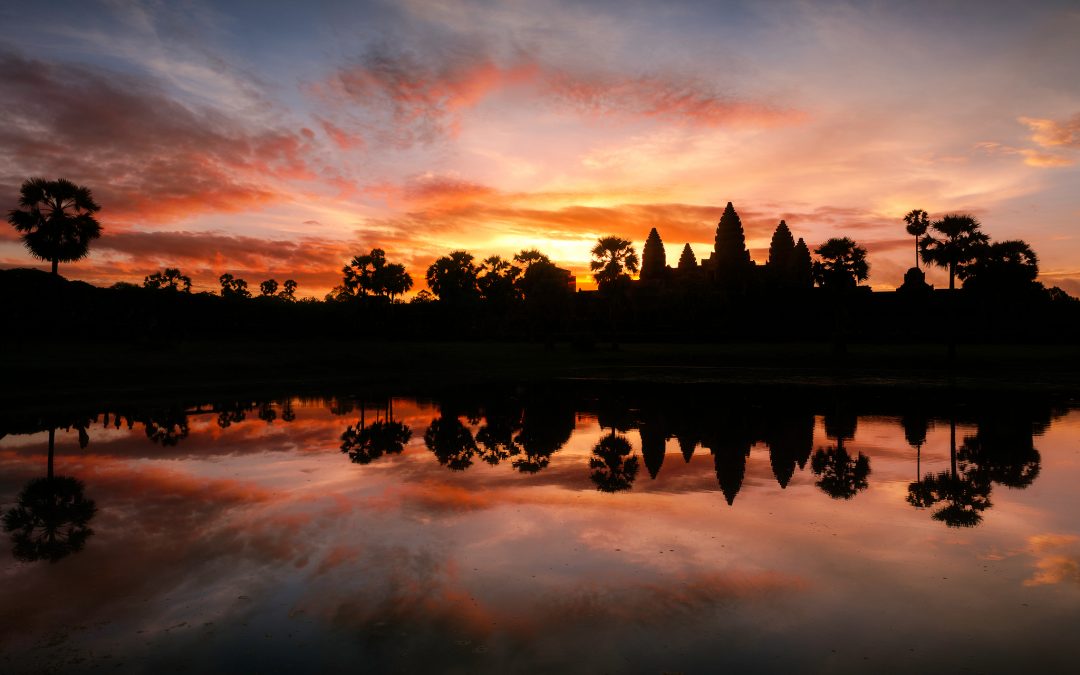Angkor Wat sits high on the Southeast Asian bucket list, and rightly so. When visiting Cambodia, you should absolutely dedicate a portion of your time to exploring the world’s largest religious site, packed with history and bas-relief carvings quite unlike anywhere else. And then there’s the iconic view of the five towers as seen from the now-famous reflecting pools. This scene has become THE quintessential Cambodia photograph, and is most commonly taken at sunrise.
Now I want you to try something:
Close your eyes or allow your mind to wander, and imagine what it feels like to stand before the ancient towers in the dim light of pre-dawn, the light slowly revealing more and more detail in the stonework, the hues of the sky gently changing as the morning sun creeps closer to the horizon…
…
…I’m guessing that standing in a crowd of 1,000+ people probably wasn’t part of your vision.
Most likely you pictured a moment of tranquillity, just you and a small gathering of people, able to take in the beauty of your surroundings in relative peace.
And therein lies the problem with Angkor Wat: like a lot of bucket list locations, the reality doesn’t live up to expectations.

The image you see here is in fact from the “Less busy” of the two reflection pools, but is in our opinion the more photogenic side.
We’ve always been a company that prides itself on honesty, and your enjoyment of our photo tours is incredibly important to us. So you can make an informed decision as to whether or not you will enjoy and/or should incorporate the sunrise into your photo tour, we’ve put together this article to help set realistc expectations.
The sunrise isn’t for everyone; we generally explain it to our guests as something you do “For the photograph, not for the experience“, but even that comes with some caveats, as you’ll find out below.
The Expectation
Let’s get something out of the way nice and early: Yes, the sunrise can be incredible. Here are some of our favourites over the time we’ve been in Cambodia.





They can also be pretty lacklustre, which leads us to…
The Reality
Timing
In truth, your luck will rarely be as good as in the photographs above. As a group, we’ve photographed the sunrise over 500 times, and have seen first hand how slim the chances are of Mother Nature giving us something special.
Getting “The Shot” is entirely dependent on the weather playing along, and when it doesn’t, we typically leave empty handed. As the adage goes, good photography and bad weather are often a winning combination; that’s not to say we’re hoping for torrential downpours, but a slim chance of rain and the accompanying cloud cover can make all the difference. Take a look at the images above and you’ll see they have some common grounds. In fact, landscape photographs taken all around the world rarely look their best with a “faultless” blue sky. Clouds are what typically provide the colour in our sunrise and sunset photographs.
Cambodia’s seasons are divided neatly into “Wet” and “Dry” – and it’s really important to stress that the name of the latter isn’t a case of over-simplification. I arrived in Cambodia in October 2014, during the rainy season. It stopped raining in mid-November, and there wasn’t another drop until May. That’s right; not a single day of rain for six months! My subsequent years in Cambodia have taught me that my first “Dry season” here was the rule, not the exception. Incidentally, I also didn’t get the first sunrise shot I was really happy with until the rainy season in 2015; the dry season is typically hazy, with washed out skies.
We all agree at ATP that you have an increased chance of colourful skies between May and November, though you also have to live with the possibility of rain – and if it does rain, we’ll just get wet. We’re well set up for rain, and have never had to cancel a tour because of the weather, but that doesn’t mean a great sunrise is a certainty. Even when it doesn’t rain, there is such a thing as too much cloud when it comes to the sunrise, and so we won’t always get THE Shot. What I’m ultimately saying here is that we’re working with fine margins; there really is only a slim chance (although a chance nonetheless) of the sunrise looking really incredible, even when here at the right time of year.
Crowding
I don’t think anyone is really expecting to be stood completely alone at the world’s most famous sunrise, but the real numbers might shock you.
You might be surprised at how many people drag themselves out of bed at 4am to see the sunrise over Angkor Wat. We’re less surprised, and that’s because we know this particular excursion is packaged into just about every large group tour that visits Siem Reap. Last year, around 2.5 million international tourists visited. Simply dividing that up by 365, that gives you over 6,800 people on a daily basis. Yes, not all of these people will visit at sunrise, and a lot of these people are travelling independently. It’s also true, however, that simply dividing by the number of days isn’t a fair representation in a country where tourism is incredibly seasonal.
The temperatures between April and November can be upwards of 40°C/105°F; for that reason, the vast majority of tourists choose to visit Siem Reap in December and January, when the temperature is much more pleasant (generally around 27°C/80°F). Angkor is always much busier during these cooler months, and that’s when the sunrise experience is at its worst. While we always do our best to assist our guests to get into the best spot for the sunrise, there’s nothing we can do to protect you from a lack of decency from other visitors; you’ll have to defend your space. Some of the less considerate tourists might push or lean into you (a technique we like to call “The human tripod”), bump you in the back of the head with selfie sticks or phones, or display plenty other sides of humanity that come about when dragged out of bed, hungry and caffeine-starved, at such a frightful time of the morning. We’ll have to endure this for over an hour as we stand in the dark, waiting for the sun to rise. Sometimes it feels quite like feeding time in the monkey pen, and we’re stood there holding the bananas.

Another shot from the “less busy” reflection pool in Angkor Wat.
Angkor is rightly becoming famous for these unruly crowds. We suggest that even in the wet season, you should expect to share the reflection pool with at least 500 people or so, and well over a thousand in the dry season. If you’re not a big fan of crowds, the experience probably isn’t for you. We firmly believe that you can experience the rest of the park in relatively peace when under the right guidance, regardless of the time of year you visit, but Angkor Wat is the exception to this rule. Most people sign up for our photography workshops looking to avoid the crowds, yet by opting to start with the sunrise, they essentially choose to have us lead them into the worst of the tourist chaos. Think carefully if that’s how you’d like to begin your day.
There’s also the “photographically challenging” side of things to consider. One of my favourite ways to shoot the sunrise, particularly when there are clouds around, is to employ long shutter speeds to emphasise the movement in the clouds. Add in a whole bunch of flashes going off, and an army of high-powered flashlights illuminating the temple so guided tours can get a sneak preview, and you have some rather difficult problems to work around. The flashlights will of course stop once there is sufficient light to see the temple with the naked eye, but the flashes will continue a while longer; you’d be surprised how few people know how to disengage the flash on their DSLR!
Other noteworthy considerations
We encourage you to ask yourself WHY you want to photograph the temple at sunrise? If it’s because, “Well everyone else has that same photograph”, why not try looking at the experience of travelling as a photographer in a different way. We pride ourselves at ATP in helping our guests to realise their photographic vision and unlock the potential of their cameras by arming them with the right tools and mindset to make beautiful images, Rather than coming with a shot list, how about showing up with an open mind and a willingness to explore; we’ll show you how to make the kinds of image you’ve always dreamed of
If you’re a beginner, and the reason you’ve decided to book one of our workshops is to take your photography skills to the next level (which we think is an awesome reason, by the way, even if you’re not a beginner), then you’ll find that talking over the noise of impatient tourists awaiting the sunrise is probably not the best learning environment. Similarly, starting in the dark is not ideal, as it represents a more challenging environment than would be the case a couple of hours later. We’re restricted in what we’re able to demonstrate given that we have very little light and can’t leave the spot we’re stood in; leave even a slight gap and someone will undoubtedly fill it. Rather, starting at a quieter temple once the sun is up, we don’t think there’s a better teaching environment; the lesser-visited temples of Angkor really are the perfect place to discover more about photography and unlock your true potential. And yes, we’d see these later in the day anyway, but we think it’s a much better way to kick off the experience.
Another Way

Angkor Wat in the afternoon sunlight during rainy season
Angkor Wat is open all day long; there really is nothing that says you HAVE to go at sunrise. In fact, visiting in the afternoon can be a much nicer experience, even photographically-speaking. Because of the direction of light in late afternoon, golden rays of light often cast uninterrupted onto the detailed façade of the temple. We think this is one of the best times to see the Wat, and it does it so much more justice than shooting it as a silhouette. While the temple is far from empty at this time (it never is, in case you were wondering), the tourists visiting in the afternoon are typically much more relaxed, and so the experience resembles feeding time at the zoo far less than is the case at sunrise.
A final note
Whether or not the sunrise is included in your photography tour is completely up to you; we’ll be happy to accommodate you regardless of your choice, and will always show up with a smile on our face (even at 4:30am, when that smile is made possible only with strong coffee!) ready to give you our all to ensure you have an experience you never forget. Yes, skipping the sunrise means myself, Régis or Alessandro gets an extra couple of hours in bed, but so do you – and it is your vacation, after all. Perhaps you’ll enjoy the day more, and take more from the morning session, when you’re not so shell-shocked from being up at 4am. We simply encourage you to consider the above and make a decision that suits you best.
